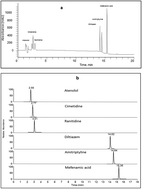Determination of pharmaceuticals in freshwater sediments using ultrasonic-assisted extraction with SPE clean-up and HPLC-DAD or LC-ESI-MS/MS detection†
Abstract
A robust and sensitive analytical method is presented for the extraction and determination of six pharmaceuticals in freshwater sediments. The pharmaceuticals were extracted from sediment using ultrasonic extraction with 2% NH4OH in methanol (MeOH), followed by extraction into 2% formic acid in MeOH and then MeOH only. The resulting extracts were then analysed, after clean-up on HLB solid phase extraction cartridges, using a single gradient run using a Zorbax Eclipse XDB-C18 (150 × 4.6 mm, 5 μm) column and a mobile phase consisting of 10 mM ammonium acetate and MeOH (pH = 4.8). Analytes were detected and quantified using either Diode Array Detector (DAD) or tandem mass spectrometry (MS/MS) with electrospray ionization in positive mode. Validation studies were carried out using ten sediments sampled from the UK and Iraq with a wide range of characteristics. The mean calculated recoveries for fortified samples in all studied sediments ranged from 74.5 to 114.6% for atenolol, 72.3 to 124.9% for amitriptyline, 76.5 to 105% for mefenamic acid and 70.1 to 102% for diltiazem. Cimetidine and ranitidine showed lower recoveries which ranged from 40.2 to 68.4% and 30.4 to 55.2% respectively. Relative standard deviations (RSD) of recoveries for all sediment–pharmaceutical combinations ranged from 1.6 to 15.8%. The detection limits in sediments for the six analytes ranged from 15 to 58.5 ng g−1 and 0.03 to 3.5 ng g−1, dry weight, for HPLC-UV and LC-ESI-MS/MS respectively. Overall the results indicate that the developed method is effective for use in monitoring the concentrations of pharmaceuticals in aquatic sediments in different regions.



 Please wait while we load your content...
Please wait while we load your content...